BOOK AN EYE EXAMINATION
Phone: 07 4942 5266
Or visit us at: North Mackay Central, 25-29 Evans Avenue. North Mackay QLD 4740
Eyes R Us is a comprehensive eye care service provider. We offer eye testing for all ages. We focus on the individual’s specific needs with examinations conducted in our welcoming, friendly rooms in North Mackay. Brad Kirkwood, our principal Optometrist, has over 20 years’ experience in ophthalmic care and brings a diverse knowledge and clinical expertise to the optometric practice. This knowledge means that Eyes R Us offers a more extensive range of services than most practices. The services we provide include:
Comprehensive eye examination
- Assess your eyes and vision for a focusing disorder – such as myopia, hypermetropia, astigmatism or presbyopia.
- Examine your eyes and related structures for any vision problems, signs of eye disease or other abnormalities such as cataract, glaucoma, age-related macular degeneration, diabetic retinopathy.
- Prescribe and dispense glasses and contact lenses, and provide expert advice on eye care.
- Refer you, if needed, to your local doctor or ophthalmologist
We can also provide expert advice on:
- Sports vision
- General eye and vision protection
- Contact lens use, designs, patient suitability and aftercare
- Fashion spectacle frames and appropriate spectacle lens designs, materials and coatings
- Sunglasses
- Driver’s license requirements
- Ergonomics and lighting
- Low vision assistance
- Colour vision
- Occupational eye safety and vision requirements
- Vision-related learning disabilities.
Emergency Eye Care
At Eyes R Us we offer an emergency eye care service for sore, red eyes and loss of vision. Treatment can be provided for conditions such as ocular foreign bodies, corneal abrasions, corneal ulcers, chemical injuries, conjunctivitis, misdirected eyelashes, iritis/uveitis and angle closure glaucoma. Signs and symptoms of flashes and floaters, and any form of loss of vision requires an urgent appointment for assessment and diagnosis. Referral to an Ophthalmologist may be required.
Children’s examination (any age)
Good vision is important for a child’s educational, physical and social development. We recommend that all children have a full eye examination with an optometrist before starting school and regularly (every two to three years) as they progress through primary and secondary school.
Eye and vision problems can occur at an age. Infant’s eye examination comprises of the assessment of ocular structures and screen for sight threatening eye conditions.
Frame repairs
With our experienced team of optical dispensers, we have outstanding follow up services including frame repairs, frame adjustments, nose pad replacements, screw replacements and frame cleaning.
Lens edging machine and fitting
At Eyes R Us we have an on-site lens edging machine lab where lenses can be edged and fitted to frames to produce a pair of glasses. We currently are edging single vision stock lenses for patients in a same day specs service. Phone us for more information regarding this service.
Other services include:
Cataract Assessment

A cataract is a clouding of the natural lens in the eye. While cataracts most commonly occur in those who are older, they can develop at any age. Risk factors include family history of cataract, previous eye trauma, medical conditions such as diabetes, chronic exposure to sunlight (ultraviolet rays) and previous eye surgery.
No vision problems or visual disability may be noticeable with early cataract changes. As the cataract advances, signs and symptoms of blurred vision, glare sensitivity, distortion or double vision in the affected eye can occur.
When symptoms begin to appear, vision may be improved with spectacles, magnification, improved lighting or other visual aids. Cataract surgery is required to restore vision. A referral to an Ophthalmologist will be arranged if surgery is required.
Diabetic Retinopathy Assessment
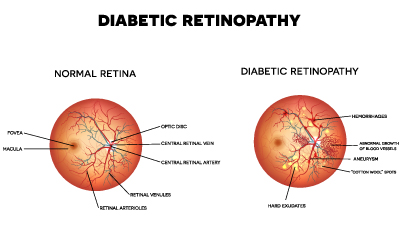
Diabetic retinopathy occurs when the retinal blood vessels are damaged as a result of diabetes. The blood vessels can swell and leak fluid in the retina. Abnormal new vessels can also grow on the retina. Diabetic retinopathy may be found before you even notice any vision problems. Blurred vision can occur if the retinal swelling or retinal bleeding occurs in the central part of your vision. Risk factors for developing diabetic retinopathy include high blood-sugar levels or poorly controlled diabetes and raised blood pressure, particularly if in conjunction with kidney disease.
This condition can cause long term visual impairment therefore regular eye examinations are important to detect diabetic retinopathy. Treatment options include intraocular injections, laser and surgical interventions. If treatment is required then a referral to an Ophthalmologist will be arranged.
Glaucoma Diagnosis and Co-Management
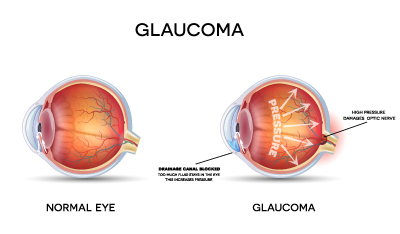
Glaucoma is the term used for a group of eye diseases where damage to the optic nerve causes loss of vision. Primary Open-Angle Glaucoma (POAG) is the most common form of glaucoma. Generally there are no symptoms or warning signs with this form of glaucoma until visual field changes are noted.
Although glaucoma can occur at any age, it is far more common in the older population. Regular eye examinations and early detection of glaucoma means that treatment can commence before a significant loss of vision occurs. Apart from age, risk factors for developing glaucoma include raised intraocular pressure and family history of glaucoma. Glaucoma treatments include eye drops, laser and other forms of surgery. Optometrists at Eyes R Us are able to diagnose, treat and co-manage glaucoma patients with Ophthalmologists.
Age-Related Macular Degeneration Assessment
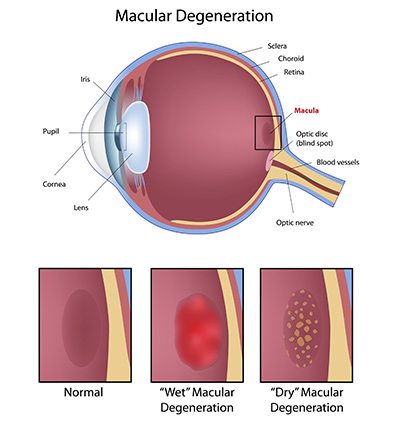
Age-related macular degeneration (also referred to as AMD or ARMD) is a disease that affects the macular region of the retina which is used for central vision. AMD affects the ability to read, write, look at detailed objects, and colour vision. Risk factors is developing AMD include increasing age, family history of AMD and history of smoking.
AMD is typically classified as either dry or wet. Dry AMD is more common and results in a gradual loss of central vision. Wet AMD can lead to sudden and significant changes in vision. There is currently no treatment for dry AMD but treatments are available for wet AMD through intraocular injections aimed at preventing the growth of abnormal blood vessels in the retina and prevent further vision loss. Referral to an Ophthalmologist is required for treatment of this condition.
Visual hallucinations may be experienced by patients with vision loss associated with AMD. This may be suggestive of Charles Bonnet Syndrome. (for more information visit: www.visionaustralia.org/learn-more/eye-conditions/charles-bonnet-syndrome)
Ocular Foreign Bodies

Foreign bodies are objects/particles hit the ocular surface and irritate the eye. Some foreign bodies embed in or on the ocular surface, while others can lodge under the upper lid. Commonly, foreign bodies occur with activities such as grinding, drilling and gardening. By wearing safety eye wear can greatly reduce the risk of ocular foreign bodies. If a foreign body is suspected an urgent examination is required for diagnosis and removal.
Corneal abrasions

Corneal abrasion occurs when mechanical trauma or chemical injury to the eye results in a defect in the epithelial surface. Common causes of traumatic corneal abrasions include fingernails, animal paws, pieces of paper or cardboard, makeup applicators and branches or leaves. Although the initial injury can be quite painful, the prognosis is usually excellent, with full recovery of vision if treatment is prompt. However, untreated corneal abrasions can lead to corneal ulcers.
Corneal ulcers
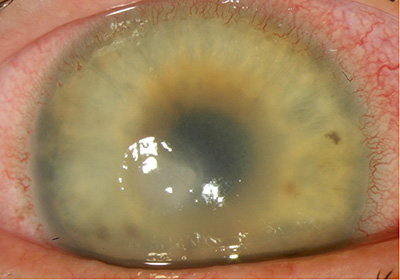
Corneal ulcers are most commonly caused by infections and can be a sight threatening condition. Urgent assessment is required for diagnosis and treatment. Most common causes are bacterial and viral infections but fungal and protozoa can also be causes. Treatment is with eye drops and/or eye ointment. Referral to an Ophthalmologist may be required.
Chemical Injuries
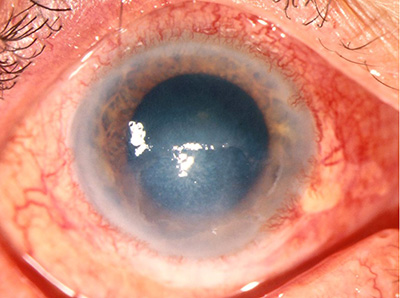
Initial treatment of any chemical burn should begin immediately at the time and place of the injury. The affected eye(s) should be irrigated copiously with running water or any available noncaustic fluid at the injury site for 15-30 minutes (the longer the better). Ideally this should be continued during the transport to an emergency eye appointment for an assessment.
Conjunctivitis

Conjunctivitis, sometimes known as ‘pink eye’, is an inflammation of the lining of the eye and eyelid caused by bacteria, viruses, or allergies. Bacterial and viral conjunctivitis can be spread by contact with eye secretions and are highly contagious and can easily spread in schools, workplaces and at home.
Conjunctivitis can also develop due to an allergic reaction to air irritants such as pollen and smoke, chlorine in swimming pools, ingredients in cosmetics, or other products that contact the eyes, such as contact lenses. Sexually transmitted diseases such as chlamydia, are less common causes of conjunctivitis.
Symptoms of conjunctivitis may be in one or both eyes and include gritty sensation, itching or burning sensation, excessive tearing, watery or mucopurulent discharge, increased sensitivity to light, swollen eyelids and pink or redness appearance.
Treatment is based on the cause. Bacterial and allergic conjunctivitis are commonly treated with eye drops and/or eye ointment. No definitive drug treatment is currently available viral conjunctivitis except for herpetic causes.
Misdirected eyelashes

Eyelashes can grow inwards towards the eye instead of outwards. This is medically known as trichiasis. Inward-turning lashes can rub against the ocular surface (cornea and conjunctiva) and irritate the eye. Trichiasis can be caused by condition such as inflammation of the eyelid and trauma. If the misdirected eyelashes are limited to a single eyelash or just a few eyelashes then removing them with forceps will remove the discomfort. They may regrow again in the wrong direction. Other treatment options include procedures such as electrolysis, laser, lid surgery and cryotherapy.
Iritis/Uveitis
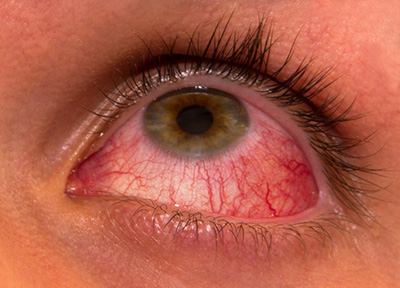
Infrequently, the eye can get inflamed internally. When this occurs the eye becomes red, sensitive to light and sore. This typically does not get better without treatment, which usually involves the use of steroid eye drops (such as prednisolone). Repeat episodes of iritis / uveitis can be linked to systemic conditions such as arthritis.
Angle Closure Glaucoma
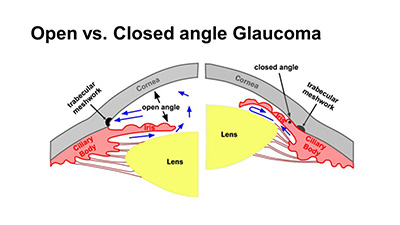
If the drainage of the aqueous inside your eye becomes inhibited then the intraocular pressure may rise to a dangerous level inside the eye. Symptoms usually begin to develop once the eye pressure exceeds about 40mmHg (normally below 20mmHg), and include eye pain, redness, blurred vision, nausea and vomiting. Urgent treatment to lower the intraocular pressure to avoid long term damage to the optic nerve.
Retinal Detachment
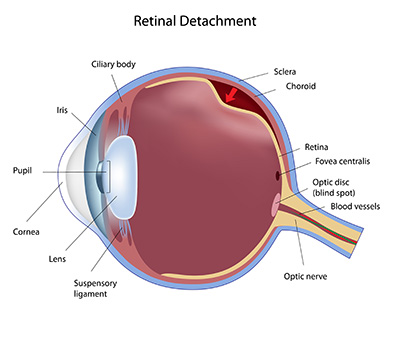
A retinal detachment, as the name implies, is when the neural layers of the retina detaches from the blood supply at the back of the eye. This is an urgent condition and needs to be assessed promptly. The sooner treatment is applied the better the prognosis. Symptoms of retinal detachment include sudden onset floaters, the appearance of flashes of light in your peripheral vision particularly noticeable at night and shadows or blurred areas in your vision.
Eyes R Us Mackay Optometrist
25/29 Evans Ave, North Mackay QLD 4740, Australia

Hours
Mon - Wed: 9:00 am - 5:00 pm
Thu: 9:00 am - 6:00 pm
Fri: 9:00 am - 5:00 pm
Address
North Mackay Central
25-29 Evans Avenue
North Mackay
QLD 4740
Contact Details
Phone:
07 4942 5266
Fax:
(07) 4942 2887